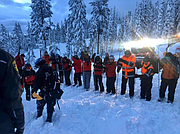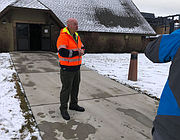Three skiers killed in Silver Mountain avalanche
KELLOGG — Following a three-day search and rescue operation, three skiers have been confirmed deceased as a result of an avalanche that occurred on Silver Mountain’s Wardner Peak Tuesday morning.
A total of 8 individuals were located– five of which only suffered minor injuries.
The massive rescue effort began on Jan. 7 when avalanches occurred on Wardner Peak’s runs, 16-to-1 and Morning Star, around 11 a.m. and trapped those who were on them at that time. Both runs, which were considered in-bounds, had just recently opened after crews from Silver Mountain had done avalanche control blasting that morning. The runs on Wardner Peak are among some of the more difficult areas of the mountain for skiers and only accessible by foot after they get off at the Chair 4 terminus.
Avalanche blasting is where mountain authorities deliberately trigger small, controlled avalanches when no one is on the slope. They do this by digging pits to examine the layers of snow or by using radar. They then start an avalanche with controlled explosives.
On smaller test slopes, authorities may also perform ski-checking by deliberately skiing along fracture lines high on the slope. This method is done with a partner who stays at a distance and can immediately act if the test goes wrong.
Ski patrol and local rescue crews were immediately mobilized after the incident to start combing the area for survivors.
The bulk of the discoveries made by rescue crews occurred on Tuesday, when they were able to rescue five trapped skiers and recover two others.
The first confirmed individual who passed, identified by the Shoshone County Sheriff’s Office as Carl William Dick Humphreys, 58, of Liberty Lake, Wash., was reportedly found earlier in the day under 10 feet of snow by rescue teams using probes.
The other deceased skier, identified as Scott Michael Parsons, 46, of Spokane Valley, Wash., was not located until much later in the day after dark. He was initially transported to Shoshone Medical Center in Kellogg, but was later pronounced deceased.
After these initial seven people had been found, Silver Mountain announced Tuesday night that “indications are all skiers are now accounted for.”
Unfortunately, this statement turned out to be incorrect, as the Resort received a phone call around 7:30 a.m. Wednesday morning from a concerned family member saying that they hadn’t heard from an individual who was on the mountain during Tuesday’s avalanches.
The suspicions of the last missing person were confirmed when authorities located her vehicle in the Silver Mountain parking lot. Along with the vehicle, officials also found the individual’s dog locked inside the car. The dog was in good health and has since been rescued.
With this new information, rescue teams returned to the mountain Wednesday morning to continue the search. On the second day, the total search team numbered approximately 80 people.
Rescue efforts on the first two days were limited to multi-person ground searches with dogs and probes. Starting with high-debris areas first, teams used a grid system to cover the terrain and search for survivors. Air support was unavailable on Tuesday and Wednesday due to heavy, low-sitting fog covering the mountainous region and an unavailability of resources.
Crews had no luck until the following day when air support was finally able to assist with the operation.
“With a short break in the weather, Two Bear Air, a search and rescue aviation support team out of Whitefish, Mont., is assisting in the search utilizing special equipment that, if successful, will significantly minimize the search area on Wardner Peak,” Undersheriff Holly Lindsey announced Thursday morning. “Also aiding in today’s search are several avalanche K-9 teams from around the Northwest.”
At approximately 12:45 p.m. on Thursday, the body of the missing 8th skier, identified as Molly Elisabeth Hubbard, 33, of Minneapolis, Minn., had been located roughly 50 hours after the initial avalanche.
“We have utilized special equipment from Two Bear Air,” Shoshone County Sheriff Mike Gunderson said. “They have technology (specifically called a Recco Detector) that they have been able to outfit their helicopters with. It helps with reflections from cellphones and other items. They were searching areas where they got reflective hits and one of those reflective hits allowed us to locate them.”
While the body had been located, it took some time to recover since it was positioned in a rugged area of the Peak.
The SCSO reported that 120 search and rescue responders had been participating in the operation on Thursday.
With the last known skier being located, rescue teams returned to the base of the mountain and discontinued the search effort Thursday afternoon.
“The Shoshone County Sheriff’s Office would like to thank the 140 volunteers that showed up from the following organizations to assist in the search efforts: KCSO/Search and Rescue, Silver Valley Search and Rescue, Silver Mountain consultants, Silver Mountain ski patrol, Shoshone County Fire District #2 and #1, Shoshone County EMS, Schweitzer ski patrol, 49 degree north ski patrol, Mt Spokane ski patrol, Lookout ski patrol, National Avalanche Center K-9 teams, Cd’A Fire Department and K-9 teams, North Idaho College, Idaho Department of Lands, Two Bear Air, and several citizen volunteers,” SCSO said in a Thursday night news release. “Our deepest condolences go out to all the family and friends affected by this tragic event.”
At the time of the avalanche, the Silver Valley (along with St. Regis, Mont.) was under a “high” avalanche danger rating from the Idaho Panhandle Avalanche Center due to the rapid loading of new snow and wind slabs over buried persistent weak layers.









